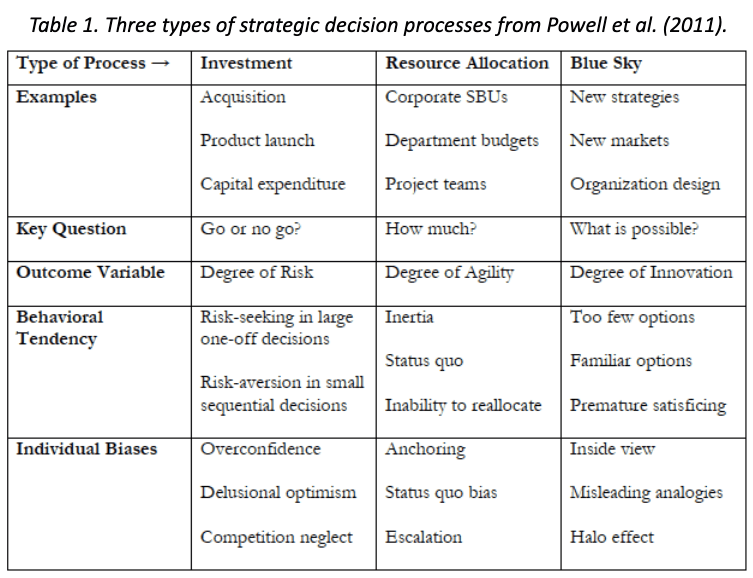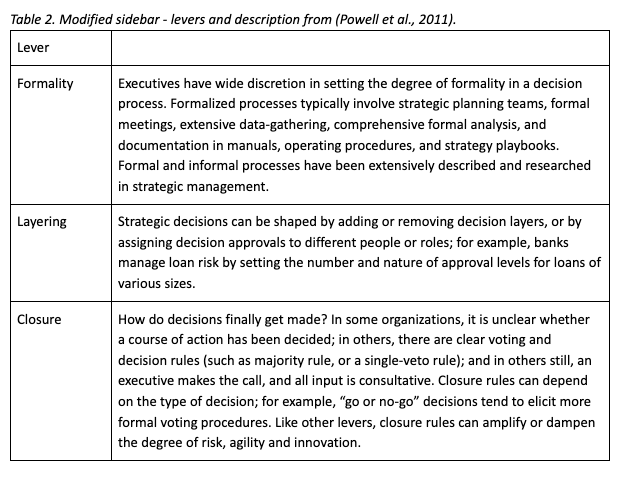
Forewarned Is Not Forearmed: A Behavioral Strategy Perspective
Blog Series: Volume I Considering the vast nature of behavioral strategy, from its theoretical framework to its strategic decision architecture, to its solutions for calibrating decision outcomes, we believe it’s better to delve into the specifics through a series of blog posts, of which this is volume I. We would love to hear whether you want to read more on this topic. This article helps you answer questions like…
- What is the budget for this project?
- How do we accelerate company growth?
- Shall we launch this product?

Making a Mistake
Decision making is inherent to human life. In organizations, leaders and executives are saddled with the responsibility of making high impact decisions. Considering typical human behavior deviates from rationality, poor choices are often made on a strategic level. Executives continue to overpay for acquisitions, unwittingly perpetuate past failures, and fail to effectively reallocate capital among business units. Why? Decision processes are barbed with cognitive biases (irrational but predictable patterns in our thinking) and noise (random variability in judgement), costing companies billions of dollars a year [1]. More so, these biases can be neutralized, amplified or dampened by organizational design.
It should be noted that, acknowledging that decision processes are barbed with individual cognitive biases is not enough; forewarned is not forearmed! Trainings designed to help individuals overcome their unconscious bias are often ineffective for the reason that biases are precisely unconscious mental events; they are persistent, difficult to directly observe, and therefore control. We tend to discover their existence after the damage has already been done. (Side note: What if we sincerely try to remove these biases? Unfortunately, it’s a bit more complicated than that. Biases are a by-product of heuristics, important intuitive shortcuts that allow us to make quick and efficient judgements.)
Unlike in the fields of economics, design, and marketing, where leaders can make use of psychology to understand the biases of others, in strategic management, decision makers need to recognize their own bias. A difficult feat. So, how do we control something we are not even aware of? The field of behavioral strategy advocates systematically removing biases from decision making processes rather than training people to overcome their unconscious biases – a more effective alternative that’s easier to implement.
What is Behavioral Strategy? How Can Leaders Benefit?
Behavioral strategy applies insights from human cognition, psychology, and behavior economics to strategic management, and real-world practice. Research practitioners argue that leaders and organizational strategists can optimize their decision making by using behavioral strategy to shift the focus from trying to overcome individual decision biases to designing behaviorally informed processes at an organizational level [2]. It empowers leaders with science-based tools to make informed effective decisions confidently and instill lasting behavioral change.
Using behavioral strategy, executives and decision makers can, for example, counteract individual biases in forecasting and risk estimation. They can become more equipped with a ‘nuanced behavioral view and can design processes that generate a degree of risk suited to their conscious risk preferences’ [2].
It’s worth noting that most behavioral strategy techniques are surprisingly easy to apply but having a strategic understanding of the underlying framework can give you a significant advantage.
That Big Decision: A Behavioral Strategy Perspective
So how does it work? Firstly, many executive decisions can be identified as one of these three major themes: (1) investment processes, (2) resource allocation, and (3) blue sky processes. As illustrated in table 1, each process is defined while considering commonly associated behavioral tendencies and individual biases. Next, formal systems for measuring these processes can be developed. Finally, leaders can cultivate an actionable toolkit (e.g., choosing the right levers for intervention) of strategic decision architecture to control outcomes.

A Behavioral Strategy Starter Pack:
Powell (2011) identified 7 powerful levers that executives can use to effectively tailor their strategic decision processes by increasing/decreasing the extent to which the following are implemented:
- Formality
- Layering
- Information
- Participation
- Incentives
- Debate
- Closure
Each decision process can benefit from a combination of levers. Considering the scope of the levers we will be discussing them in detail in volume II. Of course, you can refer to other strategies for tailoring your decision processes like Kahneman’s (2011) Decision Quality Control Checklist among other tools [3].
Let’s look at some examples…
Type 1: Investment Processes
Mergers and acquisitions, typical investment processes, are compelling times for a company, they rouse potential for overoptimistic forecasts, overconfidence or wishful thinking [2]. Alternatively, decision making surrounding ‘one-off’ investment processes may be subjected to excess risk aversion, risk taking, or investment in managerial ego [4]. Considering these individual biases are unconscious, they are likely to dribble into decision making at an organizational level, making the company susceptible to poor decisions like overpaying for acquisitions due to overestimating synergies.
In this situation, a behavioral strategist would make use of the levers: formality, layering, and closure (see table 2). Having more formalization, more decision layers, and stringent closure rules can reduce overoptimism and excess risk taking.
Alternatively, when it comes to smaller investment decisions, companies may be disadvantaged by increasing the variables of formality, layering, and closure, and fall into the category of risk aversion. In this case, it would be best to lower these levers, and adjust accordingly.

Type 2: Resource Allocation
Scarce resources are always being redistributed across departments, projects, and product groups. Despite dedicated efforts, companies can still be timid in reallocating resources and fall into an inertia trap. Alternatively, leaders seldom question their choices, the hurdle of status quo bias; we have a tendency to want things to stay the same. Decision makers often unconsciously anchor a reallocation budget to a past budget, and unwittingly perpetuate past failures.
A manager with a 50-million-dollar budget may ask for 60 million next time but never 100 million. Anchoring bias helps weave the inertia trap. Say you were seeking the methods to calibrate agility with regards to status quo bias – why not try making it a routine to actively challenge the default option [5]? For example, if a company was holding onto a business they should sell, they could submit their business units to a portfolio review. Business units would then be judged by the question “if we did not own this company, would we buy it today?”. This process allows for the investigation of growth potential and performance. Bottom line: challenge the status quo!
Type 3: Blue Sky Processes
Under this umbrella fall processes involving open ended decisions regarding topics like innovation and the general direction of the company. For example, how to accelerate company growth. While leaders strive for innovative outcomes, more often than not, they repeat old strategies, neglect new options, blindly follow the path of successful companies (the halo effect), or get psychologically attached to plausible novel ideas and ‘satisfice’. Powell refers to this as reducing a blue sky process to an investment process, that is, choosing between a couple familiar options. In order to calibrate innovation, one could use the lever of incentives. For example, the gaming company, Valve Corporation, makes use of non-monetary rewards to get an understanding of a market potential. They ask their users to suggest new products using an internal system of ‘social proofs’. Their users end up enjoying the project and the company has identified their market potential; a win-win scenario!

Things to Remember
- Behavioral strategy advocates systematically removing biases from decision making processes, rather than trying to remove unconscious biases from an individual
- Behavioral strategy does not ask you to always reduce the level of risk, but rather to consider the levels of risk as conscious strategic choices and not consequences of individual biases
- Behavioral strategy techniques are surprisingly easy to apply but having a strategic understanding of the underlying framework can give you a significant advantage
So, before you make that big decision, consider behavioral strategy as your next move; save your organization from the inevitable pitfalls of decision making.
For Your Bookshelf
- The Case for Behavioral Strategy (Lovallo & Sibony, 2010)
- You’re About to Make a Terrible Mistake (Sibony, 2020)
- Behavioral Strategy and the Strategic Decision Architecture of the Firm (Powell et al., 2011)
If you want to learn more about behavioral insights, read our blog or watch 100+ videos on our YouTube channel!
About Neurofied
Neurofied is a behavioral science company specialized in training, consulting, and change management. We help organizations drive evidence-based and human-centric change with insights and interventions from behavioral psychology and neuroscience. Consider us your behavioral business partner who helps you build behavioral change capabilities internally.
Since 2018, we have trained thousands of professionals and worked with over 100 management, HR, growth, and innovation teams of organizations such as Johnson & Johnson, KPMG, Deloitte, Novo Nordisk, ABN AMRO, and the Dutch government. We are also frequent speakers at universities and conferences.
Our mission is to democratize the value of behavioral science for teams and organizations. If you see any opportunities to collaborate, please contact us here.
Sources
[1] Khaneman, D., Rosenfield, A., Gandhi, L., Blaser, T., (2016) Noise: How to Overcome the High, Hidden Cost of Inconsistent Decision Making. Harvard business review magazine.
[2] Powell, T. C., Lovallo, D., & Fox, C. R. (2011). Behavioral strategy. Strategic Management Journal, 32(13), 1369-1386.
[3] Kahneman, D., Lovallo, D., & Sibony, O. (2011). Before you make that big decision. Harvard business review, 89(6), 50-60.
[4] Drucker, P., (1964) Managing for Results. Harper & Row.
[5] Sibony, O. (2020). You’re About to Make a Terrible Mistake. Swift Press.
Lovallo, D., & Sibony, O. (2010). The case for behavioral strategy. McKinsey Quarterly.
